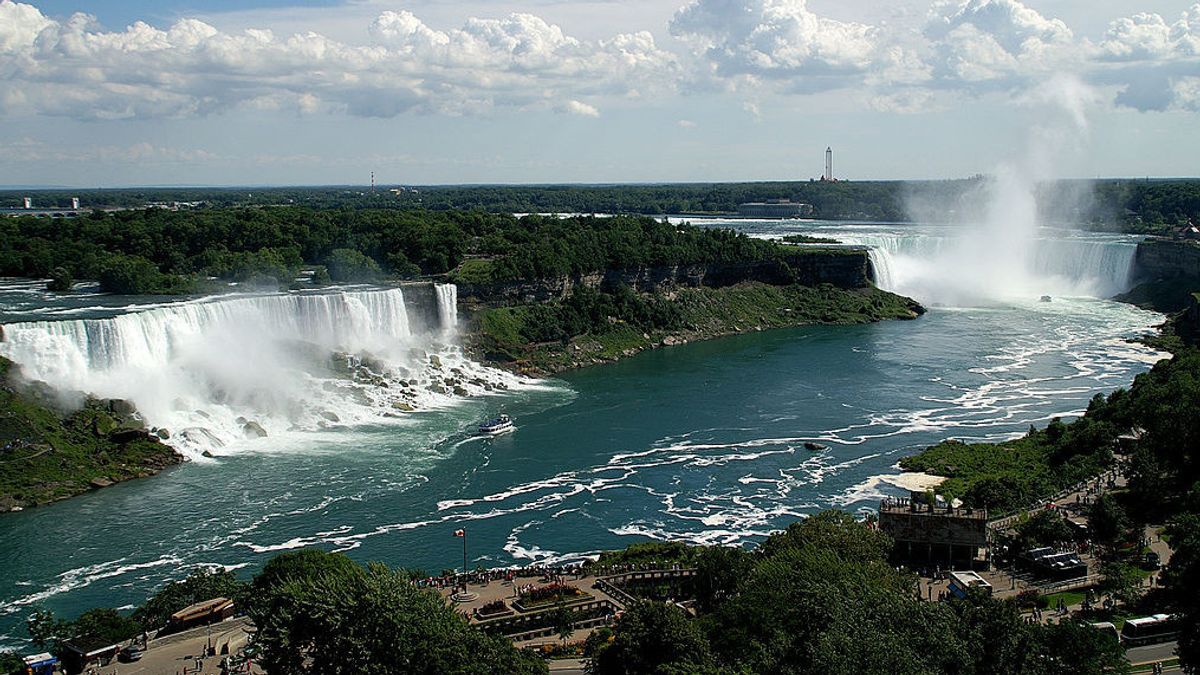JAKARTA - On January 2, 1929, the United States (US) and Canada agreed to combine efforts to divert the Niagara River. The two countries hope to protect Niagara Falls. A waterfall which is one of the largest tourist attractions in North America.
Quoting Today I Found Out, Niagara Falls actually has three separate waterfalls, namely the Horseshoe Falls (Canada), the American Falls, and the smaller Bridal Veil Falls. These Falls were formed more than 12,000 years ago during the Wisconsin Glacier. This period occurred during the last ice age when water from the Great Lakes flowed through the Niagara Slopes into the Atlantic Ocean.
In the 19th century, industrialists harnessed the power of Niagara Falls for hydroelectric power (PLTA). In 1885, there were concerns on both sides of the Falls regarding corporate misuse, so the Niagara Water Allocation Bill was drafted to protect the area from private developers. The bill led to the creation of the Niagara Reservation State Park in New York (New York's first State Park) and the Queen Victoria Niagara Falls Park in Ontario, Canada.
The US and Canada rejoined in 1929 to slow down the erosion process and generate more hydropower. An agreement was signed on January 2, 1929 between the two countries authorizing the allocation of US $ 2 million, or about US $ 27 million today, for construction work on the Niagara River. The plan is to direct strong currents and carry out excavations in certain areas to make the Falls more attractive, while slowing down the effects of erosion.
As explained earlier, the water flowing in Niagara Falls comes from the Great Lakes. Ninety percent of the water passes through Horseshoe Falls. Initially, as much as 5.5 billion gallons of water per hour flowed over the waterfall. Currently the numbers are controlled by the Canadian and US governments to slow erosion. In addition, part of the water is diverted to provide power to the US and Canada, making Niagara Falls the largest source of electricity in the world.
The average river below Niagara Falls has a depth of about 51 meters. The brave people who passed the waterfall usually hit the riverbed before coming back to the surface.
Niagara Falls has become a popular tourist attraction, thanks in large part to human intervention. Experts control the flow of water flowing over Niagara Falls, even increasing the flow during the busy tourist season. But it seems that that's what keeps people who have visited Niagara Falls, not coming back. As Ginger Strand, author of 'Inventing Niagara: Beauty, Power and Lies' put it.
“There's an interesting contradiction in being, on the one hand, being popular because it's wild, big and wild. And on the other hand, it's becoming popular because it's starting to be tamed and made a little less wild. "
Niagara Falls has also become one of the most popular honeymoon destinations in the world since promoters in the area made "honeymooning" a tradition in the mid-nineteenth century. The 1953 film Niagara, starring Marilyn Monroe, depicts Monroe on her honeymoon with wandering eyes. The film marked Monroe as a film phenomenon perhaps because it featured two full minutes of Monroe walking towards a waterfall for a better view.
Annie Edson Taylor is known to be the first person to go to Niagara Falls in a barrel. Taylor was a poor widow when she arrived in Niagara Falls in 1901. The woman saw her action as a way to make money. After hiring a manager, he challenged Niagara Falls on October 24, 1901, in a vat he designed himself. He survived, but didn't end up with the financial windfall he had hoped for. He worked as a street vendor around Niagara for twenty years and died penniless.
The English, Chinese, Japanese, Arabic, and French versions are automatically generated by the AI. So there may still be inaccuracies in translating, please always see Indonesian as our main language. (system supported by DigitalSiber.id)











